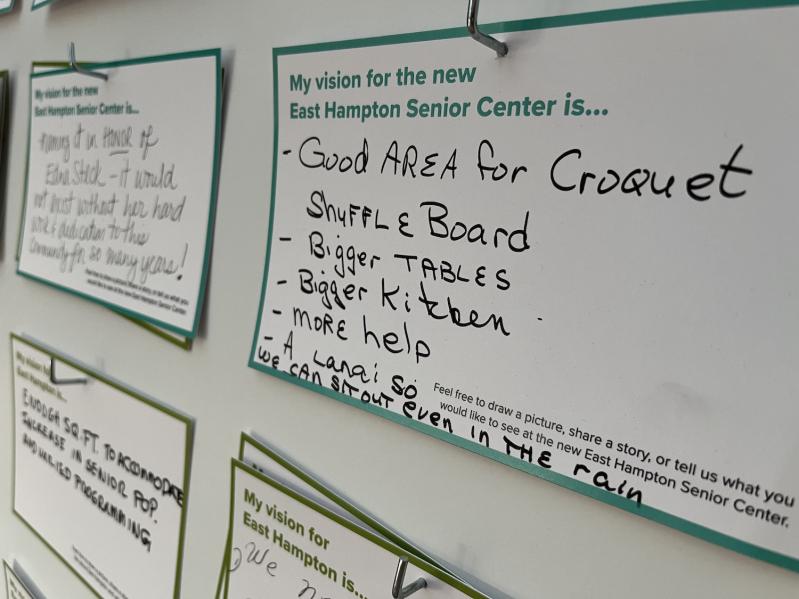The East Hampton Town Board has set Feb. 1 as a tentative date to decide whether to exempt the proposed new senior citizens center, to be constructed on Abraham’s Path in Amagansett, from the town’s zoning and land-use procedures.
To do so, the project would come under what is known as a Monroe “balancing of public interests” analysis.
At the end of a discussion on Tuesday, board members unanimously appeared ready to free the senior center from planning, zoning, and architectural review board oversight, meaning that the town board itself would be the only agency to approve it. Councilman Ian Calder-Piedmonte, who was appointed to the board last week to fill the vacancy created by Kathee Burke-Gonzalez’s election to supervisor, indicated that he will abstain from the vote, citing his lack of involvement in the planning and deliberations.
Were the senior center subject to the town’s zoning standards and procedures, according to Jeremy Samuelson, the town’s planning director, it would require subdivision, site plan approval, and a special permit from the planning board, as well as area variances from the zoning board of appeals for total lot coverage, building coverage, and gross floor area.
“The current center,” on Springs-Fireplace Road in East Hampton, “has been deemed woefully inadequate for the types of programs and services needed to meet the current and future needs of the town’s growing adult community,” Supervisor Burke-Gonzalez said at Tuesday’s meeting. The new center, she said, will provide critical town services to residents “in a light-filled, thoughtfully designed, well-functioning, A.D.A.-compliant, net-zero building.”
The board’s discussion followed a presentation by a consultant on the center’s potential environmental impacts.
Before that, several residents had spoken up to object not only to the size and cost of the facility, most recently put at $31.6 million, but also to its proposed exemption from zoning and land-use procedures, on the grounds that the town board would be usurping that authority from its own appointed boards.
“I am comfortable that the town board has the authority to perform the Monroe balancing test,” Ms. Burke-Gonzalez responded after conferring with legal counsel. “The board would not be acting in excess of its jurisdiction or powers if it were to exempt the senior center from the town’s zoning.”
The nine factors involved in a Monroe analysis are complex, but involve, among other things, the “encroaching government’s legislative grant of authority”; the function or land use, the “effect of local land use regulation” upon the project; possible other locations in less restrictive zoning areas; the impact upon “legitimate local interests”; “alternative methods of providing the proposed improvement”; the “extent of the public interest to be served,” and “intergovernmental participation in the project development process and an opportunity to be heard.”
Not all are always relevant, not any one is determinative, and any one factor can be the most important.
Councilwoman Cate Rogers said the project should be exempted from zoning and land-use procedures because all nine factors were met. Councilman David Lys agreed, adding that the existing senior citizens center is “in a building that is almost derelict,” which he called “shameful.” “East Hampton deserves this,” he said of the new building.
“I understand the complexities of adapting [the Monroe analysis] to this project,” said Councilman Tom Flight, who was sworn in on Jan. 2. “I also feel that as elected members of this town, it is our duty to try to deliver the best services for our community. My concern is, were we to use the Monroe principle for this, what potentially comes next?”
“What do you think we may miss?” he wondered, addressing colleagues who have served on the planning board or the Z.B.A. But he did support the proposed exemption. “I do think the need is definitively there,” he said.
Mr. Calder-Piedmonte indicated that he will abstain from the vote, citing his lack of involvement in the center’s planning and deliberations. “My instincts, though, are that, as a town, for important projects, [we] go through the other boards,” he said.
Mr. Calder-Piedmonte was on the planning board for 12 years. “I served for a long time on planning, and it’s just a different process.” He added, however, that “in terms of the senior center as a whole and in general, I’m supportive.”
For two years, said Ms. Burke-Gonzalez, she has been meeting every other week with Diane Patrizio, the director of human resources; Mr. Samuelson; the project’s architects, and other department heads “to go through the development of this plan. . . . So the level of scrutiny by town staff is enormous and unprecedented.”
The board has the option to receive input from planning staff and residents “to ensure the greatest amount of participation in the project, and that’s what I would recommend,” the supervisor said. “My vote would be for us to employ the Monroe balancing test, to have the town serve as lead agency, but go to those boards for referrals and recommendations, but not for final approval.”Mr. Samuelson and Ms. Patrizio are to deliver a presentation on client usage, demographics, and the need for senior citizens services at the board’s work session on Tuesday, at which time the architects will present a design recap.




